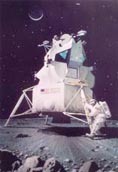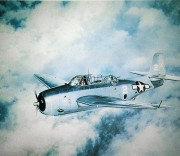|
Fright Flight™
We are reviving this much-neglected part of our magazine. Please check out what’s new and what’s planned.--Ed., November 2004
You glance up from the sectional chart and your heart nearly stops. No horizon. No greens and browns. Only a milky movie screen on which your terror begins to magnify. You´re immersed in the damp, gauzy grip of a cumulonimbus cloud. And without so much as an instrument rating!
Rain in big ugly drops begins to thud against your windscreen. What was that? Lightning!
Before you can curse yourself for being so stupid, you notice the heading indicator beginning to spin; the plane is wandering. You´ve dropped the reigns of your mighty steed, and he´s galloping off on his own.
And with him, the airspeed indicator! It´s racing toward the redline. The wind noise rises from a muted rush, barely detectable above the engine´s sound, to a screaming howl, like that of a wild beast, the one your´re riding earthward to an early grave.
Panic overtakes you. Sweat gushes into your eyes, nearly blinding you. You feel a heaviness in your seat. A surge of nausea and dizziness washes over you. Is this the end? What you do next will tell the tale.
[This little episode, one I originally tried to make light of as an introduction to this feature, actually happened to me. And it really wasn’t funny at all. I’m going to tell that story at a later date.]
Embry Riddle Aerobatic Accident--Preliminary report
- Final Report on American Airlines Flight 587, an Airbus A300-605R (N14053) that lost its vertical stabilizer and crashed in Queens, N.Y., on November 12, 2001, just after the World Trade Center attacks, prompting fears of a follow-up attack by terrorists.
* * *
Embry Riddle Aerobatic Accident
On August 28, 2004, about 0840 mountain standard time, two American Champion Aircraft 8KCAB, N561ER and N562ER, collided in midair while performing formation aerobatics 7 miles east of Ernest A. Love Field, Prescott, Arizona.
The area is flat open desert in Prescott Valley. Both airplanes were
owned and operated by Embry-Riddle Aeronautical University (ERAU) under the provisions of 14 CFR Part 91, and were destroyed. The commercial pilot of N561ER, and the airline transport pilot of N562ER, both sustained fatal injuries. The personal flights departed Ernest A. Love Field (PRC), Prescott, at 0818 the morning of the accident. Day visual meteorological conditions prevailed, and no flight plan had been filed. The purpose of the flight was to practice a routine for the University's homecoming/open house.
The wreckage of N561ER was at 34 degrees 37.591 minutes north latitude and 112 degrees 14.672 minutes west longitude. The elevation was 5,080 feet. The wreckage of N562ER was at 34 degrees 37.534 minutes north latitude and 112 degrees 14.598 minutes west longitude. The elevation was 5,071 feet.
Both pilots were faculty members of ERAU and had many years of aerobatic experience. Both pilots were also responsible for the development and implementation of the University's Emergency Maneuvers and Upset Recovery Training program and had been instructing in it for several years.
Witnesses who were hunting antelope in the area reported that the two airplanes had been practicing aerobatics in the area for about a week. Consequently the hunters had become familiar with the routine. They indicated that the airplanes had completed the routine and were setting up for a second run through the routine when the accident occurred.
One witness about 250 yards south of the accident site stated that the airplanes had made a dive, recovered, and then pulled straight up wing tip to wing tip. As the airplanes "fell to the left" the wings touched, and then the tails connected. After that N561ER "dove straight in," and N562ER came down south of N561ER.
Another witness about 1/2 mile north of the accident site stated the airplanes did a stall/spin maneuver and pulled out low to the ground. Then, while in formation, the airplanes pulled straight up in a hammerhead maneuver and collided. The witness believed that prior to the collision, he saw one aircraft in front of the other. The rear airplane (61) then collided with the other airplane (62). He also indicated that he thought the collision was after the completion of the hammerhead maneuver. After the collision both airplanes "went out of control," and hit the ground.
During the on-scene examination, matching of color transfers and the dimensions and shapes of mass intrusions on the structures of each aircraft revealed that N561ER's tail contacted the wing strut of N562ER. The elevator of N561ER contacted the landing gear strut of N562ER.
N561ER came to rest about 370 feet north of N562ER.
But what about you? Have a real-life Fright Flight you´d like to share with me and your fellow aviators? Hopefully, we can all learn something from the experiences of our brothers and sisters in flight. Send us your story to SUBMISSIONS.
|


